Fire Protection Issues for Historic Buildings – Canadian Conservation Institute (CCI) Notes 2/6
(PDF Version, 1.44 MB)
CCI Note 2/6 is part of CCI Notes Series 2 (Preventive Conservation)
Introduction
Hundreds of historic buildings have been completely destroyed by fire because, in the past, protection systems were not available. Unfortunately, serious losses still occur every year. Fire not only damages historic building components, it often destroys numerous irreplaceable collections. Given today's fire protection technology, such losses should not occur. Only through effective fire protection methods will we succeed in preserving our built history for future generations. This Note discusses critical issues to consider when upgrading and installing fire protection systems in historic buildings, specifically in historic house museums.
Inherent Fire Hazards
Historic house museums are more vulnerable to fire than other museums. This is mostly the result of their high combustibility ratings and a general lack of building compartmentalization (subdivision). Wood framing used throughout the entire structure becomes very dry over the years and can ignite easily. Basement ceiling joists (Figure 1) and wall framing in attics and crawl spaces are often left unprotected. Varnished wood decor and countless numbers of combustible contents including large furniture pieces, mattresses, drapes, and area rugs, for example, provide substantial fuel. This is further compounded by the presence of open grand staircases usually rising up several floors (Figure 2). Such vertical openings provide a generous source of oxygen, and act as chimney flues that allow flames, hot gases, heat, and smoke to spread very quickly. Often fire spreads so fast that it cannot be put out by fire extinguishers. Even small fires that are contained can cause tremendous damage to a collection, and indirect effects such as smoke damage can often extend to the entire building.
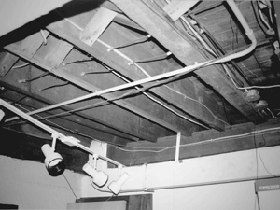
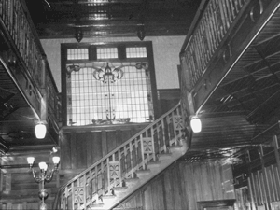
Fire Risks
Most fire risks found during site reviews can be dealt with easily and with minimum difficulty or expense. Eliminating these risks is an important part of fire safety, especially in unprotected buildings. The first step towards sound fire protection is prevention—a quick way to prevent fire losses (CCI Technical Bulletin 18, "Fire Prevention Programs for Museums").
Unsafe wiring is still a major fire risk. Temporary electrical wiring (Figure 3) can be easily replaced by permanent wiring. Extension cords (often running under area rugs) should be removed and permanent electrical outlets installed. Knob-and-tube wiring should be replaced by new and approved wiring. Lighting fixtures (Figure 4) should meet local electrical codes, and building wiring should be inspected every 10 years by a qualified electrician.
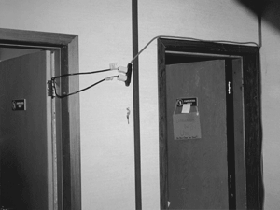
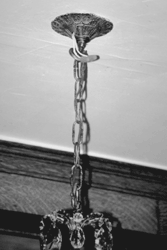
Open-flame appliances are also a serious fire risk. Oil lamps, candles, wood stoves, and wood-burning fireplaces should not be used, especially if the building is not protected by an automatic sprinkler system. Open flames are difficult to make safe, and can cause unwanted smoke alarms when lit. Thermal fire detectors could be used instead, but unfortunately they do not provide the early fire detection needed in historic house museums. If wood-burning appliances are used, effective fire prevention methods should be in place to minimize their risks. For example, full-size fireplace screens should be installed to contain flying embers, and flue screens should be installed to prevent roof shingle fires. Dry wood (instead of green wood) should be used to reduce the risk of chimney fires.
Commissioning annual chimney cleaning and inspections can ensure safer operations as well. Effective closing-down procedures, such as safe disposal of ashes, along with on-site supervision during the entire wood-burning operation and one hour following closing can reduce fire risks substantially.
Another important fire risk, and lately the principal cause of fire in historic buildings, is arson. Effective exterior lighting accompanied by a security alarm system can help keep vandals at a distance. However, very little can be done to protect museums against a determined arsonist, other than installing an automatic sprinkler system throughout the building.
Building Codes and Regulations
Protecting life should be the first and foremost fire protection objective of any museum. Compliance with the regulations prescribed in the National Building Code of Canada and provincial building codes should provide adequate life safety for building occupants. However, it is crucial to note that these codes are not intended to protect property. Their main objective is to preserve life by regulating safe and adequate emergency exits for the building's occupants, and by protecting neighbouring buildings against fire spread. Building codes do not reflect concern over the possibility of fire destroying the building and its collections, as long as people are evacuated safely and the fire is confined. In other words, compliance with mandatory building codes does not usually provide adequate fire protection for irreplaceable buildings and collections. Museums are encouraged to contact the Authority Having Jurisdiction (AHJ) in their area (usually the local or provincial fire marshal) to ensure compliance with prescribed standards before opening to the public.
Challenges and Dilemmas
Installing adequate property protection without infringing on historic integrity is the single biggest challenge facing the architect, the engineer, and the contractor. Although sensitive and often original fabrics must be preserved, contractors need access inside walls and ceilings. This is best provided by meticulous planning, and by hiring experienced professionals knowledgeable about historic and sensitive interiors. Installing fire alarm wiring and sprinkler pipes in rooms finished with period wallpaper, ornate wood moldings, and historic fabrics, without causing undue damage, requires special work methods. Installing sprinklers and fire detectors in the least obtrusive way possible requires experienced, professional installers, and, most of all, good planning.
The second biggest challenge is convincing museum managers to provide adequate fire protection. Most are unaware of a museum's vulnerability to fire, and some do not realize historic buildings burn to the ground each year. The fear of water damage and loss of historic integrity are common reasons for refusing to install automatic sprinkler and fire alarm systems. Some believe fire will not happen to them, and a great number believe the collection is safe because the fire department is just a few minutes away.
Funding can also be a major hurdle for the manager. Convincing the purse holders can be difficult, especially in times of restraint. Relocating collections to a temporary site, providing and installing equipment, and patching walls and ceilings can be costly. However, fire damage can be even more costly. A case in point is the fire in at the Billings Estate Museum, Ottawa, Ontario. Fire losses were estimated at $125,000, which did not include the Canadian Conservation Institute's (CCI) collection treatment expenses. The cost to install an automatic sprinkler system including a new water main was under $100,000. In this case, the City of Ottawa paid twice—to restore the museum and to install the system. Unfortunately, this is not unusual; many institutions install sprinkler systems following a fire. Insurance underwriters may cover some of the damage, but cannot replace one-of-a-kind buildings or original objects lost in a fire.
Automatic Sprinklers
Fire hazards can be controlled adequately by an automatic sprinkler system installed throughout the building. A major undertaking indeed, but necessary to ensure building and collection preservation. Fear of water damage and loss of historic integrity is not warranted or a good enough reason for risking the loss of rare buildings and irreplaceable collections. The danger of accidental water discharge is very low. Sprinkler leakage loss reports from the National Fire Protection Association (NFPA) show that the chance of a sprinkler opening accidentally because it is defective is less than 1 in 16 million installed sprinklers per yearFootnote 1. On the other hand, water damage from fire department hose line operations is tremendous. On average, automatic sprinklers deliver water at the rate of 113.75 L (25 gallons) per minute at the seat of the fire; however, fire department hose lines can deliver 10 times that amount in a large area and with extreme pressure. In some instances, the news media have mistakenly reported water damage caused by fire department hose line operations as sprinkler damage.
The cost of automatic sprinkler systems can be kept low by selecting conventional wet-pipe systems; on/off sprinklers, pre-action systems, and cycling systems are more expensive to install and maintain, and do not necessarily provide better protection. Many of these special systems are plagued with maintenance problems and are hardly ever required in museums.
Sprinklers do not have to infringe on the historic makeup of the building, and can be installed in subtle ways. They can be recessed in ceilings (Figure 5), or blended with architectural wood finishes (Figure 6). Recess covers can be painted (only by the manufacturer) to match existing ceiling colour, texture, or wood grain. Experienced installers and a conscientious contractor can find innovative and imaginative solutions to mount sprinklers inconspicuously. The number of sprinklers in a room can be minimized by installing extended coverage sprinklers. Up to 37 m2 (44.4 square yards) can be covered by a single sprinkler in some cases. Building damage and overall costs can be kept to a minimum by using special tools. Safe, quick, and easy pipe assembly methods can be used in place of dangerous welding and brazing methods. For example, electric resistance tools and electric pressing tools can make the assembly of copper and galvanized piping safe and easy. Thermoplastic piping is now permitted by code in wet-pipe systems with the AHJ's permission. It is easily routed in difficult and often inaccessible spaces, assembles in minutes, and is non-corrosive and shock resistant. It is also a much-needed feature in areas requiring seismic protection. Using the right type of piping for a particular installation and custom tools is another key factor in lowering damages and controlling costs.
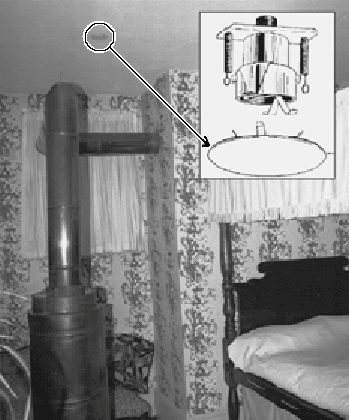
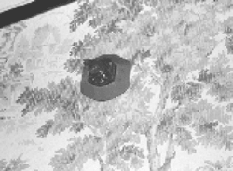
Many historic house museums have already installed automatic sprinkler systems with substantial success. Spadina House (Toronto, Ontario), Whitehern (Hamilton, Ontario), Dundurn Castle (Hamilton), Colborne Lodge (Toronto), Dawson City Museum (Dawson City, Yukon), and Craigdarroch Castle (Victoria, British Columbia) are some examples.
Conclusion
With protection systems available to preserve our historic buildings for future generations, there is no reason to risk losing our heritage to fire. More effort should be made by the museum community as a whole, and by all levels of government, to support and encourage historic building managers to provide adequate fire protection systems.
CCI staff can advise museums on effective systems and sound installation methods. CCI can also assist in convincing heritage building and financial managers to install adequate fire protection systems through awareness and building reviews. CCI has been instrumental in the successful installation of numerous systems, specifically at Craigdarroch Castle where historic integrity was of paramount importance, and the Dawson City Museum where extremely low temperatures were a serious issue in system design. CCI staff often work along with institutions such as le Centre de conservation du Québec, the National Research Council of Canada, the Smithsonian Institution, and the National Fire Protection Association Technical Committee for the Protection of Cultural Resources to arrive at sound decisions.
Recommended Reading
-
Bailey, Alan, Donald Insall, and Philip Kilshaw. Fire Protection Measures for the Royal Palaces. London: London Department of National Heritage, .
-
Baril, Paul. "Fire Prevention Programs for Museums." CCI Technical Bulletin 18. Ottawa: Canadian Conservation Institute, .
-
Canadian Conservation Institute. "Automatic Sprinkler Systems for Museums." CCI Notes 2/8. Ottawa: Canadian Conservation Institute, .
-
Canadian Conservation Institute. "Museum Fires and Losses." CCI Notes 2/7. Ottawa: Canadian Conservation Institute, .
-
Culture Shock. A video produced by Linda Swenson of Chubb & Son Inc., Boston University, American and New England Studies Program, and the National Center for Preservation Technology and Training Grants Program.
-
Fire Safety Retrofitting in Historic Buildings. Washington, DC: Advisory Council on Historic Preservation and General Services Administration, .
-
Heritage Under Fire: A Guide to Protection of Historic Buildings. London: Fire Protection Association, .
-
Marchant, E. W. "Preventing Fire in Historic Buildings: The Acceptable Risk." Fire Technology, vol. 25, nº 2 (), pp. 67–69.
-
NFPA 914. Recommended Practice for Fire Protection in Historic Structures, . [NFPA publications are available by calling the Canadian Association of Fire Chiefs at 613-736-0576, or the NFPA directly at 800-344-3355.]
Written by Paul Baril
Copies are also available in French.
Texte également publié en version française.
© Minister of Public Works and Government Services,
Cat. Nº NM95-57/2-6-1998E
ISSN 0714-6221